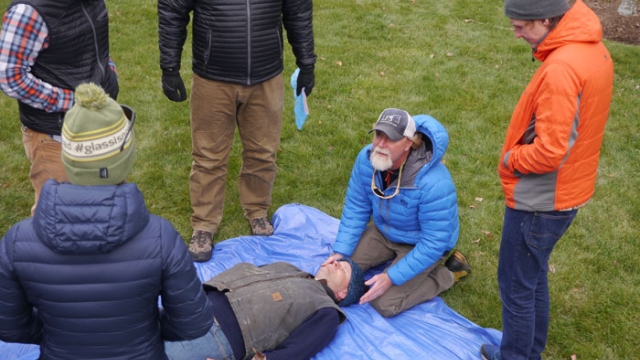
Photos: Wilderness First-Aid Training with Orvis Travel
http://ift.tt/2iLGBX4
Instructor Mike Tayloe discusses the importance of protecting the spine in any outdoor emergency.
Photos by By Tyler Atkins, except where noted
The folks at
spend a ton of time on the water and in the field with clients, so they need to be prepared for all kinds of problems—from sunburn to compound fractures. That’s why they’re all certified in Wilderness First-Aid. To stay current, everyone has to get re-certified every two or three years, depending on the course, so the company brought in Mike Tayloe, of
, to teach the course at the Orvis Fly Fishing School last week. Senior Manager of Orvis Adventures, Scott McEnaney, asked me if I wanted to take the course, and I jumped at the opportunity.
We learned how a SAM Splint can be molded into a cervical collar in the field.
The first thing you have to know about Tayloe (which is what everyone calls him) is that his
. He’s been a paramedic for more than 20 years, focusing on remote and wilderness medicine, and he has provided remote medical services from Mount Everest to Antarctica. What makes him perfect for Orvis is that he’s also a fly-fishing guide in Colorado and Chile.
Stopping bleeding in the field is sometimes job #1, and we learned several tourniquet methods.
Photo by Phil Monahan
I’ve taken first-aid and CPR courses several times throughout my career, but this one was extremely hands-on, and Tayloe was able to make everything relevant to the field work that Orvis Travel hosts do all the time. And Tayloe wasn’t okay with practicing our skills in the classroom; instead he would take four or five of us outside, give us medical conditions to simulate, and then bring the rest of the class out to treat the injured. This was how I found myself lying akimbo in a drift boat in 30-degree weather. Each of us had to assess and treat a variety of conditions–from spine injuries to hypothermia to stroke—and we also worked on moving patients out of dangerous situations.
What do you do when the patient is as big as Pete Kutzer? Orvis Travel host Kim Bryant learns the proper way to use leverage to turn a larger patient over.
Most fly fishers spend a lot of time off the road and away from regular emergency response options, so I highly recommend a 24-hour Wilderness First Aid course. I know that I now feel a lot more confident that I can handle an emergency on the water or in the woods, when time may be of the essence. I hope that I never have to use many of the skills I learned from Tayloe, but I’ll be awfully glad I know what to do when the you-know-what goes down in the backcountry. Tayloe has agreed to write some posts on wilderness first aid, so stay tuned.
Two oars and a tarp can make a perfectly serviceable stretcher, if you do it right.
Orvis Travel’s Dan Davala shows off a custom H3-tube leg splint.
We practiced wound care on some filthy chicken breasts that required cleaning and closing.
I’m unconscious in the boat! Scott McEnaney stabilizes my spine. But how to get me out?
Step one: prepare the stretcher.
Step 2: Use teamwork to lift me without causing more harm.
Step 3: Now that I’m stable, they can treat my injuries.
fishing
via Fly Fishing – Orvis News https://news.orvis.com
December 4, 2017 at 09:11AM
